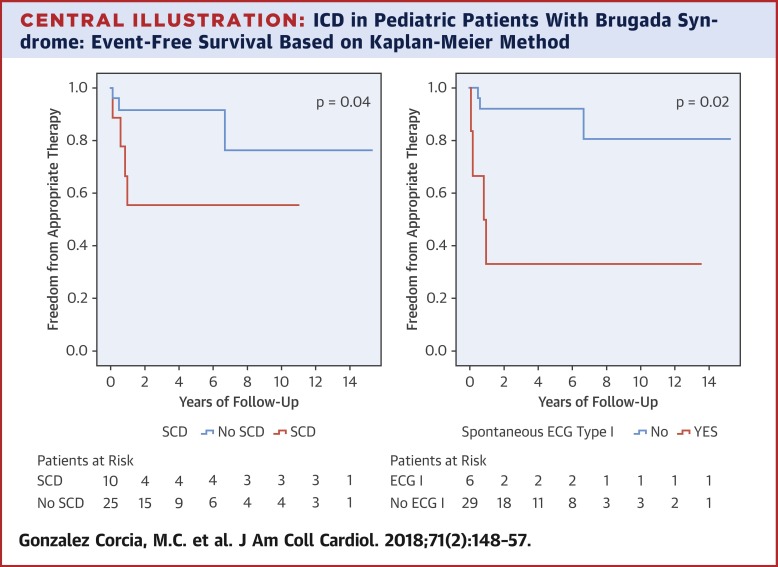当前位置:
X-MOL 学术
›
J. Am. Coll. Cardiol.
›
论文详情
Our official English website, www.x-mol.net, welcomes your
feedback! (Note: you will need to create a separate account there.)
Implantable Cardioverter-Defibrillators in Children and Adolescents With Brugada Syndrome
Journal of the American College of Cardiology ( IF 21.7 ) Pub Date : 2018-01-01 , DOI: 10.1016/j.jacc.2017.10.082 M. Cecilia Gonzalez Corcia , Juan Sieira , Gudrun Pappaert , Carlo de Asmundis , Gian Battista Chierchia , Mark La Meir , Andrea Sarkozy , Pedro Brugada
Journal of the American College of Cardiology ( IF 21.7 ) Pub Date : 2018-01-01 , DOI: 10.1016/j.jacc.2017.10.082 M. Cecilia Gonzalez Corcia , Juan Sieira , Gudrun Pappaert , Carlo de Asmundis , Gian Battista Chierchia , Mark La Meir , Andrea Sarkozy , Pedro Brugada

|
BACKGROUND
Young patients presenting with symptomatic Brugada syndrome have very high risks for ventricular arrhythmias and should be carefully considered for implantable cardioverter-defibrillator (ICD) placement. However, this therapy is associated with high rates of inappropriate shocks and device-related complications. OBJECTIVES
This study investigated clinical features, management, and long-term follow-up of young patients with Brugada syndrome and ICD. METHODS
Patients diagnosed with Brugada syndrome, who underwent implantation of an ICD at an age of ≤20 years, were studied. RESULTS
The study included 35 consecutive patients. The mean age at ICD placement was 13.9 ± 6.2 years. Ninety-two percent were symptomatic; 29% presented with aborted sudden cardiac death and 63% with syncope. During a mean follow-up period of 88 months, sustained ventricular arrhythmias were treated by the ICD in 9 patients (26%), including shocks in 8 patients (23%) and antitachycardia pacing in 1 patient (3%). Three patients (9%) died in an electrical storm. Seven patients (20%) experienced inappropriate shocks, and 5 patients (14%) had device-related complications. Aborted sudden cardiac death and spontaneous type I electrocardiogram were identified as independent predictors of appropriate shock occurrence. CONCLUSIONS
ICD therapy is an effective strategy in young patients with symptomatic Brugada syndrome, treating potentially lethal arrhythmias in >25% of patients during follow-up. Appropriate shocks were significantly associated with previously aborted sudden cardiac death and spontaneous type I electrocardiograms. However, ICDs are frequently associated with complications and inappropriate shocks, both of which remain high regardless of careful device implantation and programming.
中文翻译:

Brugada 综合征儿童和青少年的植入式心脏复律除颤器
背景 出现有症状的 Brugada 综合征的年轻患者发生室性心律失常的风险非常高,应慎重考虑植入植入式心律转复除颤器 (ICD)。然而,这种疗法与不适当电击和设备相关并发症的高发生率有关。目的 本研究调查了 Brugada 综合征和 ICD 年轻患者的临床特征、管理和长期随访。方法 对诊断为 Brugada 综合征且在 20 岁以下接受 ICD 植入的患者进行研究。结果 该研究包括 35 名连续患者。放置 ICD 的平均年龄为 13.9 ± 6.2 岁。92% 有症状;29% 出现流产性心源性猝死,63% 出现晕厥。在平均 88 个月的随访期内,9 名患者 (26%) 使用 ICD 治疗持续性室性心律失常,包括 8 名患者 (23%) 的电击和 1 名患者 (3%) 的抗心动过速起搏。三名患者 (9%) 死于雷暴。7 名患者 (20%) 经历了不适当的电击,5 名患者 (14%) 出现了与器械相关的并发症。中止心源性猝死和自发性 I 型心电图被确定为适当休克发生的独立预测因素。结论 ICD 治疗是有症状的 Brugada 综合征年轻患者的有效策略,在随访期间治疗了超过 25% 的患者的潜在致死性心律失常。适当的电击与先前中止的心源性猝死和自发性 I 型心电图显着相关。然而,
更新日期:2018-01-01
中文翻译:

Brugada 综合征儿童和青少年的植入式心脏复律除颤器
背景 出现有症状的 Brugada 综合征的年轻患者发生室性心律失常的风险非常高,应慎重考虑植入植入式心律转复除颤器 (ICD)。然而,这种疗法与不适当电击和设备相关并发症的高发生率有关。目的 本研究调查了 Brugada 综合征和 ICD 年轻患者的临床特征、管理和长期随访。方法 对诊断为 Brugada 综合征且在 20 岁以下接受 ICD 植入的患者进行研究。结果 该研究包括 35 名连续患者。放置 ICD 的平均年龄为 13.9 ± 6.2 岁。92% 有症状;29% 出现流产性心源性猝死,63% 出现晕厥。在平均 88 个月的随访期内,9 名患者 (26%) 使用 ICD 治疗持续性室性心律失常,包括 8 名患者 (23%) 的电击和 1 名患者 (3%) 的抗心动过速起搏。三名患者 (9%) 死于雷暴。7 名患者 (20%) 经历了不适当的电击,5 名患者 (14%) 出现了与器械相关的并发症。中止心源性猝死和自发性 I 型心电图被确定为适当休克发生的独立预测因素。结论 ICD 治疗是有症状的 Brugada 综合征年轻患者的有效策略,在随访期间治疗了超过 25% 的患者的潜在致死性心律失常。适当的电击与先前中止的心源性猝死和自发性 I 型心电图显着相关。然而,











































 京公网安备 11010802027423号
京公网安备 11010802027423号